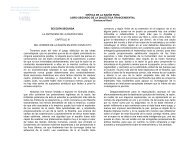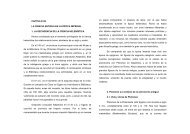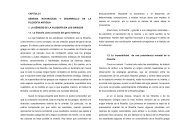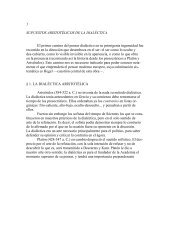46 THE PHILOSOPHY OF THE ITALIAN RENAISSANCE 18 Petrarch [1.24], 66, 78–9; Petrarch [1.26], 31 (I.25); Petrarch [1.28], 662–4; Augustine, De civitate Dei VIII.9–10 and XXII.7, De vera religione III.3, Confessions III.iv.7; see also Foster [1.34], 170; Gerosa [1.35], 246, 252–3. 19 On Bruni see Dizionario [1.4], vol. 14, 618–33; Bruni [1.56], 21–42. Aside from Aristotle, Bruni translated works by Plato, Demosthenes, Aeschines, Xenophon and Plutarch. 20 Bertalot [1.57], vol. 2, 132–3; Bruni [1.46], vol. 1, 17 (I.8); see also Cammelli [1. 63], vol. 1; Schmitt and Skinner [1.17], 86–7; Schmitt [1.16], 68; Gerl [1.65], 125– 6. 21 Bruni [1.46], vol. 2, 88, 216 (VII.4; X.24); Bruni [1.56], 208, 210, 213; Bruni [1.47], 77, 84–6. 22 Bruni [1.56], 68–9 (Dialogi); see also Gilbert [1.36], 209; Vasoli [1.19], 26. 23 Garin [1.64], 62–8. 24 Petrarch [1.24], 67; Bruni [1.56], 82, 91, 226, 229; Bruni [1.47], 48, 77; see also Seigel [1.18], ch. 4. Cicero’s praise (Academica II.xxxviii.119, De finibus I.v.14; Topica I.3) was based on Aristotle’s lost exoteric works, not on the so-called school treatises we now have. 25 See Alonso de Cartagena’s Liber in Birkenmajer [1.59], 168, 173, 175; Bruni [1. 56], 201–6; see also Garin [1.64], 63–4; Schmitt and Skinner [1.17], 79, 90. 26 Bruni [1.56], 45. For the prefaces to his Aristotle translations, see Bruni [1.47], 70– 81, 120–1. 27 Bruni [1.56], 59–60, 268; see also Garin [1.6], 151–2; Vasoli [1.19], 23–7; Gilbert [1.36], 205–13. 28 Cammelli [1.63], vol. II; Dizionario [1.4], vol. 4, 129–31; Field [1.92], ch. 5; for his inaugural lectures, see Müllner [1.51], 3–56. 29 Argyropulos [1.42]. He translated Aristotle’s Categories, De interpretation, Prior and Posterior Analytics, as well as Porphyry’s Isagoge: see Cammelli [1.63], vol. 2, 183–4; Garin [1.64], 83–5. 30 Müllner [1.51], 43. He translated the Physics, De caelo and De anima: Cammelli [1.63], vol. 2, 183; Garin [1.64], 84–5. 31 Müllner [1.51], 51–2: he describes Alexander’s opinion as ‘quite false and totally abhorrent’, and Averroes’s as ‘extremely dangerous’; in support <strong>of</strong> the Christian position, he produced ‘some rational arguments based on natural philosophy’, as well as those based on ‘faith’; see also Garin [1.5], 102–5. 32 Argyropulos [1.43]. 33 Acciaiuoli [1.41]; see also Bianchi [1.58]; Field [1.92], ch. 8. He wrote a similar commentary on the Politics. 34 George translated the Physics, De anima, De generatione et corruptione, De caelo, the zoological works and the Rhetoric, as well as the Pseudo-Aristotelian Problems: Garin [1.64], 75–81; see also Monfasani [1.103]. 35 George <strong>of</strong> Trebizond [1.49], 142–3, 191, 268; see also Monfasani [1.103], 26, 42, 76–7; Minio-Paluello [1.67], 264–5; Schmitt and Skinner [1.17], 77, 88. 36 George <strong>of</strong> Trebizond [1.49], 106–7. Gaza retranslated the zoological works and the Problems, as well as translating Latin works, such as Cicero’s De senectute, into Greek; on Gaza see Monfasani in Hankins et al. [1.8], 189–219, esp. 207–19; on Bessarion see Mohler [1.102], vol. 1; Garin [1.64], 74–5. 37 In 1452 he was imprisoned for brawling with another humanist in the chancery <strong>of</strong> the papal Curia: Monfasani [1.103], 109–11.
RENAISSANCE AND SEVENTEENTH-CENTURY RATIONALISM 47 38 George <strong>of</strong> Trebizond [1.49], 107, 132–3; George <strong>of</strong> Trebizond in Mohler [1.102], vol. 3, 277–342 (Adversus Theodorum Gazam in perversionem Problematum Aristotelis); see also Monfasani [1.103], 152–4 39 George <strong>of</strong> Trebizond in Mohler [1.102], vol. 3, 319 (Adversus Theodorum Gazam); George <strong>of</strong> Trebizond [1.49], 142; see also Monfasani [1.103], 155–6; Garin [1.6], 288–9. He also treated scholastic logicians with respect and drew on their works in his Isagoge dialectics. 40 Poliziano [1.53], 303 (Miscellanea I.90); see also Garin [1.64], 78–80; Dizionario [1.4], vol. 2, 691–702. 41 Poliziano [1.53], 310 (Miscellanea I, Coronis), 529–30 (Praelectio de dialectica), 502 (Praefatio in Suetonii expositionem); see also Klibansky [1.97], 316; Branca [1.61], 13. The Praelectio de dialectica, a by-product <strong>of</strong> Poliziano’s teaching, became a standard introduction to Aristotelian logic: Schmitt [1.16], 61. 42 Poliziano [1.54], xiv–xxiii, 18; Poliziano [1.53], 179 (Epistolae XII); see also Wolters [1.69]. 43 Dizionario [1.4], vol. 4, 96–9; Branca [1.60]; Branca [1.61], 13–15. Aside from his Aristotelian work, Barbaro also produced philological commentaries on Pliny’s Natural <strong>History</strong> (Castigationes Plinianae) and on Dioscorides. 44 Barbaro [1.44] is based on his lectures; see also Kristeller [1.10], vol. 1, 337–53. 45 Barbaro [1.45], vol. 1, 16–17, 92, 104–5 (Epp. XII, LXXII, LXXXI), vol. 2, 108 (Oratio ad discipulos); see also Garin [1.64], 87–9; Dionisotti in Medioevo [1.13], vol. 1, 217–53; Branca [1.62], 131–3. 46 Pico [1.166]; see also Kristeller [1.182], 56–8; Valcke [1.197], 191; Roulier [1. 193], 85–6; Branca [1.60], 227–8. 47 Barbaro Epistolae, vol. 1, 77–8 (Ep. LXI); see also Branca [1.62], 132. 48 See Kretzmann et al. [1.38], 74–8; Kristeller [1.10], vol. 1, 341–2 n. 13. 49 Branca [1.62], 131, 166–7; Nardi [1.14], 366–8. 50 Manutius [1.50], vol. 1, 5–7, 13–18, 22–3; see also Minio-Paluello [1.67], 489–93. 51 Cavalli [1.48], a 2 v ; Manutius [1.50], vol. 1, 14; see also Schmitt in Poppi [1.68], 287–314. 52 Manutius [1.50], vol. 1, 7, 17; see also p. 40 below. 53 Minio-Paluello [1.67], 489, 496; Mahoney [1.66]; Mahoney in Poppi [1.68], 135– 202. 54 Vernia [1.55], 89 v ; see also Mahoney [1.126], 169–70; Mahoney in Poppi [1.68], 156; Mahoney [1.66], 149–63; Schmitt and Skinner [1.17], 493–4; Di Napoli [1.3], 181–93. Vernia corresponded with Barbaro: see Barbaro [1.44], vol. 1, 79–80 (Ep. LXII). 55 Paul <strong>of</strong> Venice [1.52], z7 r –8 r ; see also Kuksewicz in Olivieri [1.15], vol. 2, 297– 324; Schmitt and Skinner [1.17], 490. 56 Klibansky [1.96]. 57 Bruni [1.47], 4; translation in Hankins [1.95], vol. 1, p. 50; Bruni [1.46], vol. 1, 15– 16 (I.8); see also Garin in Medioevo [1.13], vol. 1, 339–74, esp. 361–3; Di Napoli [1.3], 125. 58 Bertalot [1.57], vol. 2, 269. 59 Bruni [1.46], vol. 2, 148 (IX.4); Hankins [1.95], vol. 1, 58–81. For Bruni’s second version <strong>of</strong> the Crito (1424–7) see Plato [1.82]; he also translated the Apology (1424): see Garin in Medioevo [1.13], vol. 1, 365; for his knowledge <strong>of</strong> the Cratylus see Bruni [1.46], vol. 1, 11–12 (1.6).
- Page 2 and 3:
Routledge History of Philosophy Vol
- Page 4 and 5:
Routledge History of Philosophy Vol
- Page 6 and 7:
v 1. Philosophy, Renaissance. 2. Ph
- Page 8 and 9:
vii Glossary 389 Index of names 407
- Page 10 and 11:
element in learning about the natur
- Page 12 and 13:
J.G.Cottingham is Professor of Phil
- Page 14 and 15:
xiii Politics and Religion The Arts
- Page 16 and 17:
xv Politics and Religion The Arts 1
- Page 18 and 19:
xvii Politics and Religion The Arts
- Page 20 and 21:
xix Politics and Religion The Arts
- Page 22 and 23:
xxi Politics and Religion The Arts
- Page 24 and 25: xxiii Politics and Religion The Art
- Page 26 and 27: xxv Politics and Religion The Arts
- Page 28 and 29: xxvii Politics and Religion The Art
- Page 30 and 31: 2 RENAISSANCE AND SEVENTEENTH-CENTU
- Page 32 and 33: 4 RENAISSANCE AND SEVENTEENTH-CENTU
- Page 34 and 35: 6 RENAISSANCE AND SEVENTEENTH-CENTU
- Page 36 and 37: 8 RENAISSANCE AND SEVENTEENTH-CENTU
- Page 38 and 39: 10 RENAISSANCE AND SEVENTEENTH-CENT
- Page 40 and 41: 12 RENAISSANCE AND SEVENTEENTH-CENT
- Page 42 and 43: 14 RENAISSANCE AND SEVENTEENTH-CENT
- Page 44 and 45: 16 THE PHILOSOPHY OF THE ITALIAN RE
- Page 46 and 47: 18 THE PHILOSOPHY OF THE ITALIAN RE
- Page 48 and 49: 20 THE PHILOSOPHY OF THE ITALIAN RE
- Page 50 and 51: 22 THE PHILOSOPHY OF THE ITALIAN RE
- Page 52 and 53: 24 THE PHILOSOPHY OF THE ITALIAN RE
- Page 54 and 55: 26 THE PHILOSOPHY OF THE ITALIAN RE
- Page 56 and 57: 28 THE PHILOSOPHY OF THE ITALIAN RE
- Page 58 and 59: 30 THE PHILOSOPHY OF THE ITALIAN RE
- Page 60 and 61: 32 THE PHILOSOPHY OF THE ITALIAN RE
- Page 62 and 63: 34 THE PHILOSOPHY OF THE ITALIAN RE
- Page 64 and 65: 36 THE PHILOSOPHY OF THE ITALIAN RE
- Page 66 and 67: 38 THE PHILOSOPHY OF THE ITALIAN RE
- Page 68 and 69: 40 THE PHILOSOPHY OF THE ITALIAN RE
- Page 70 and 71: 42 THE PHILOSOPHY OF THE ITALIAN RE
- Page 72 and 73: 44 THE PHILOSOPHY OF THE ITALIAN RE
- Page 76 and 77: 48 THE PHILOSOPHY OF THE ITALIAN RE
- Page 78 and 79: 50 THE PHILOSOPHY OF THE ITALIAN RE
- Page 80 and 81: 52 THE PHILOSOPHY OF THE ITALIAN RE
- Page 82 and 83: 54 THE PHILOSOPHY OF THE ITALIAN RE
- Page 84 and 85: 56 THE PHILOSOPHY OF THE ITALIAN RE
- Page 86 and 87: 58 THE PHILOSOPHY OF THE ITALIAN RE
- Page 88 and 89: 60 THE PHILOSOPHY OF THE ITALIAN RE
- Page 90 and 91: 62 THE PHILOSOPHY OF THE ITALIAN RE
- Page 92 and 93: 64 THE PHILOSOPHY OF THE ITALIAN RE
- Page 94 and 95: 66 RENAISSANCE PHILOSOPHY OUTSIDE I
- Page 96 and 97: 68 RENAISSANCE PHILOSOPHY OUTSIDE I
- Page 98 and 99: 70 RENAISSANCE PHILOSOPHY OUTSIDE I
- Page 100 and 101: 72 RENAISSANCE PHILOSOPHY OUTSIDE I
- Page 102 and 103: 74 RENAISSANCE PHILOSOPHY OUTSIDE I
- Page 104 and 105: 76 RENAISSANCE PHILOSOPHY OUTSIDE I
- Page 106 and 107: 78 RENAISSANCE PHILOSOPHY OUTSIDE I
- Page 108 and 109: 80 RENAISSANCE PHILOSOPHY OUTSIDE I
- Page 110 and 111: 82 RENAISSANCE PHILOSOPHY OUTSIDE I
- Page 112 and 113: 84 RENAISSANCE PHILOSOPHY OUTSIDE I
- Page 114 and 115: 86 RENAISSANCE PHILOSOPHY OUTSIDE I
- Page 116 and 117: 88 RENAISSANCE PHILOSOPHY OUTSIDE I
- Page 118 and 119: 90 RENAISSANCE PHILOSOPHY OUTSIDE I
- Page 120 and 121: 92 RENAISSANCE PHILOSOPHY OUTSIDE I
- Page 122 and 123: 94 RENAISSANCE PHILOSOPHY OUTSIDE I
- Page 124 and 125:
96 RENAISSANCE PHILOSOPHY OUTSIDE I
- Page 126 and 127:
98 SCIENCE AND MATHEMATICS UP TO DE
- Page 128 and 129:
100 SCIENCE AND MATHEMATICS UP TO D
- Page 130 and 131:
102 SCIENCE AND MATHEMATICS UP TO D
- Page 132 and 133:
104 SCIENCE AND MATHEMATICS UP TO D
- Page 134 and 135:
106 SCIENCE AND MATHEMATICS UP TO D
- Page 136 and 137:
108 SCIENCE AND MATHEMATICS UP TO D
- Page 138 and 139:
110 SCIENCE AND MATHEMATICS UP TO D
- Page 140 and 141:
112 SCIENCE AND MATHEMATICS UP TO D
- Page 142 and 143:
114 SCIENCE AND MATHEMATICS UP TO D
- Page 144 and 145:
116 SCIENCE AND MATHEMATICS UP TO D
- Page 146 and 147:
118 SCIENCE AND MATHEMATICS UP TO D
- Page 148 and 149:
120 SCIENCE AND MATHEMATICS UP TO D
- Page 150 and 151:
122 SCIENCE AND MATHEMATICS UP TO D
- Page 152 and 153:
124 SCIENCE AND MATHEMATICS UP TO D
- Page 154 and 155:
126 SCIENCE AND MATHEMATICS UP TO D
- Page 156 and 157:
128 SCIENCE AND MATHEMATICS UP TO D
- Page 158 and 159:
CHAPTER 4 Francis Bacon and man’s
- Page 160 and 161:
132 FRANCIS BACON AND MAN’S TWO-F
- Page 162 and 163:
134 FRANCIS BACON AND MAN’S TWO-F
- Page 164 and 165:
136 FRANCIS BACON AND MAN’S TWO-F
- Page 166 and 167:
138 FRANCIS BACON AND MAN’S TWO-F
- Page 168 and 169:
140 FRANCIS BACON AND MAN’S TWO-F
- Page 170 and 171:
142 FRANCIS BACON AND MAN’S TWO-F
- Page 172 and 173:
144 FRANCIS BACON AND MAN’S TWO-F
- Page 174 and 175:
146 FRANCIS BACON AND MAN’S TWO-F
- Page 176 and 177:
148 FRANCIS BACON AND MAN’S TWO-F
- Page 178 and 179:
150 FRANCIS BACON AND MAN’S TWO-F
- Page 180 and 181:
152 FRANCIS BACON AND MAN’S TWO-F
- Page 182 and 183:
154 FRANCIS BACON AND MAN’S TWO-F
- Page 184 and 185:
CHAPTER 5 Descartes: methodology St
- Page 186 and 187:
158 RENAISSANCE AND SEVENTEENTH-CEN
- Page 188 and 189:
160 RENAISSANCE AND SEVENTEENTH-CEN
- Page 190 and 191:
162 RENAISSANCE AND SEVENTEENTH-CEN
- Page 192 and 193:
164 RENAISSANCE AND SEVENTEENTH-CEN
- Page 194 and 195:
166 RENAISSANCE AND SEVENTEENTH-CEN
- Page 196 and 197:
168 RENAISSANCE AND SEVENTEENTH-CEN
- Page 198 and 199:
170 RENAISSANCE AND SEVENTEENTH-CEN
- Page 200 and 201:
172 RENAISSANCE AND SEVENTEENTH-CEN
- Page 202 and 203:
174 RENAISSANCE AND SEVENTEENTH-CEN
- Page 204 and 205:
176 RENAISSANCE AND SEVENTEENTH-CEN
- Page 206 and 207:
178 RENAISSANCE AND SEVENTEENTH-CEN
- Page 208 and 209:
180 RENAISSANCE AND SEVENTEENTH-CEN
- Page 210 and 211:
182 RENAISSANCE AND SEVENTEENTH-CEN
- Page 212 and 213:
184 RENAISSANCE AND SEVENTEENTH-CEN
- Page 214 and 215:
186 RENAISSANCE AND SEVENTEENTH-CEN
- Page 216 and 217:
188 RENAISSANCE AND SEVENTEENTH-CEN
- Page 218 and 219:
190 RENAISSANCE AND SEVENTEENTH-CEN
- Page 220 and 221:
192 RENAISSANCE AND SEVENTEENTH-CEN
- Page 222 and 223:
194 RENAISSANCE AND SEVENTEENTH-CEN
- Page 224 and 225:
196 RENAISSANCE AND SEVENTEENTH-CEN
- Page 226 and 227:
198 RENAISSANCE AND SEVENTEENTH-CEN
- Page 228 and 229:
200 RENAISSANCE AND SEVENTEENTH-CEN
- Page 230 and 231:
202 RENAISSANCE AND SEVENTEENTH-CEN
- Page 232 and 233:
204 RENAISSANCE AND SEVENTEENTH-CEN
- Page 234 and 235:
206 RENAISSANCE AND SEVENTEENTH-CEN
- Page 236 and 237:
208 RENAISSANCE AND SEVENTEENTH-CEN
- Page 238 and 239:
210 RENAISSANCE AND SEVENTEENTH-CEN
- Page 240 and 241:
212 RENAISSANCE AND SEVENTEENTH-CEN
- Page 242 and 243:
214 RENAISSANCE AND SEVENTEENTH-CEN
- Page 244 and 245:
216 RENAISSANCE AND SEVENTEENTH-CEN
- Page 246 and 247:
218 RENAISSANCE AND SEVENTEENTH-CEN
- Page 248 and 249:
220 RENAISSANCE AND SEVENTEENTH-CEN
- Page 250 and 251:
222 RENAISSANCE AND SEVENTEENTH-CEN
- Page 252 and 253:
224 RENAISSANCE AND SEVENTEENTH-CEN
- Page 254 and 255:
226 RENAISSANCE AND SEVENTEENTH-CEN
- Page 256 and 257:
228 RENAISSANCE AND SEVENTEENTH-CEN
- Page 258 and 259:
230 RENAISSANCE AND SEVENTEENTH-CEN
- Page 260 and 261:
232 RENAISSANCE AND SEVENTEENTH-CEN
- Page 262 and 263:
234 RENAISSANCE AND SEVENTEENTH-CEN
- Page 264 and 265:
236 RENAISSANCE AND SEVENTEENTH-CEN
- Page 266 and 267:
238 RENAISSANCE AND SEVENTEENTH-CEN
- Page 268 and 269:
240 RENAISSANCE AND SEVENTEENTH-CEN
- Page 270 and 271:
242 RENAISSANCE AND SEVENTEENTH-CEN
- Page 272 and 273:
244 RENAISSANCE AND SEVENTEENTH-CEN
- Page 274 and 275:
246 RENAISSANCE AND SEVENTEENTH-CEN
- Page 276 and 277:
248 RENAISSANCE AND SEVENTEENTH-CEN
- Page 278 and 279:
250 RENAISSANCE AND SEVENTEENTH-CEN
- Page 280 and 281:
252 RENAISSANCE AND SEVENTEENTH-CEN
- Page 282 and 283:
254 RENAISSANCE AND SEVENTEENTH-CEN
- Page 284 and 285:
256 RENAISSANCE AND SEVENTEENTH-CEN
- Page 286 and 287:
258 RENAISSANCE AND SEVENTEENTH-CEN
- Page 288 and 289:
260 RENAISSANCE AND SEVENTEENTH-CEN
- Page 290 and 291:
262 RENAISSANCE AND SEVENTEENTH-CEN
- Page 292 and 293:
264 RENAISSANCE AND SEVENTEENTH-CEN
- Page 294 and 295:
266 RENAISSANCE AND SEVENTEENTH-CEN
- Page 296 and 297:
268 RENAISSANCE AND SEVENTEENTH-CEN
- Page 298 and 299:
270 RENAISSANCE AND SEVENTEENTH-CEN
- Page 300 and 301:
272 RENAISSANCE AND SEVENTEENTH-CEN
- Page 302 and 303:
274 RENAISSANCE AND SEVENTEENTH-CEN
- Page 304 and 305:
276 RENAISSANCE AND SEVENTEENTH-CEN
- Page 306 and 307:
278 RENAISSANCE AND SEVENTEENTH-CEN
- Page 308 and 309:
280 RENAISSANCE AND SEVENTEENTH-CEN
- Page 310 and 311:
282 RENAISSANCE AND SEVENTEENTH-CEN
- Page 312 and 313:
284 RENAISSANCE AND SEVENTEENTH-CEN
- Page 314 and 315:
286 RENAISSANCE AND SEVENTEENTH-CEN
- Page 316 and 317:
CHAPTER 9 The moral and political p
- Page 318 and 319:
290 RENAISSANCE AND SEVENTEENTH-CEN
- Page 320 and 321:
292 RENAISSANCE AND SEVENTEENTH-CEN
- Page 322 and 323:
294 RENAISSANCE AND SEVENTEENTH-CEN
- Page 324 and 325:
296 RENAISSANCE AND SEVENTEENTH-CEN
- Page 326 and 327:
298 RENAISSANCE AND SEVENTEENTH-CEN
- Page 328 and 329:
300 RENAISSANCE AND SEVENTEENTH-CEN
- Page 330 and 331:
302 RENAISSANCE AND SEVENTEENTH-CEN
- Page 332 and 333:
304 RENAISSANCE AND SEVENTEENTH-CEN
- Page 334 and 335:
306 RENAISSANCE AND SEVENTEENTH-CEN
- Page 336 and 337:
308 RENAISSANCE AND SEVENTEENTH-CEN
- Page 338 and 339:
310 RENAISSANCE AND SEVENTEENTH-CEN
- Page 340 and 341:
312 RENAISSANCE AND SEVENTEENTH-CEN
- Page 342 and 343:
314 RENAISSANCE AND SEVENTEENTH-CEN
- Page 344 and 345:
316 RENAISSANCE AND SEVENTEENTH-CEN
- Page 346 and 347:
318 RENAISSANCE AND SEVENTEENTH-CEN
- Page 348 and 349:
CHAPTER 10 Occasionalism Daisie Rad
- Page 350 and 351:
322 RENAISSANCE AND SEVENTEENTH-CEN
- Page 352 and 353:
324 RENAISSANCE AND SEVENTEENTH-CEN
- Page 354 and 355:
326 RENAISSANCE AND SEVENTEENTH-CEN
- Page 356 and 357:
328 RENAISSANCE AND SEVENTEENTH-CEN
- Page 358 and 359:
330 RENAISSANCE AND SEVENTEENTH-CEN
- Page 360 and 361:
332 RENAISSANCE AND SEVENTEENTH-CEN
- Page 362 and 363:
334 RENAISSANCE AND SEVENTEENTH-CEN
- Page 364 and 365:
336 RENAISSANCE AND SEVENTEENTH-CEN
- Page 366 and 367:
338 RENAISSANCE AND SEVENTEENTH-CEN
- Page 368 and 369:
340 RENAISSANCE AND SEVENTEENTH-CEN
- Page 370 and 371:
342 RENAISSANCE AND SEVENTEENTH-CEN
- Page 372 and 373:
344 RENAISSANCE AND SEVENTEENTH-CEN
- Page 374 and 375:
346 RENAISSANCE AND SEVENTEENTH-CEN
- Page 376 and 377:
348 RENAISSANCE AND SEVENTEENTH-CEN
- Page 378 and 379:
350 RENAISSANCE AND SEVENTEENTH-CEN
- Page 380 and 381:
352 RENAISSANCE AND SEVENTEENTH-CEN
- Page 382 and 383:
354 LEIBNIZ: TRUTH, KNOWLEDGE AND M
- Page 384 and 385:
356 LEIBNIZ: TRUTH, KNOWLEDGE AND M
- Page 386 and 387:
358 LEIBNIZ: TRUTH, KNOWLEDGE AND M
- Page 388 and 389:
360 LEIBNIZ: TRUTH, KNOWLEDGE AND M
- Page 390 and 391:
362 LEIBNIZ: TRUTH, KNOWLEDGE AND M
- Page 392 and 393:
364 LEIBNIZ: TRUTH, KNOWLEDGE AND M
- Page 394 and 395:
366 LEIBNIZ: TRUTH, KNOWLEDGE AND M
- Page 396 and 397:
368 LEIBNIZ: TRUTH, KNOWLEDGE AND M
- Page 398 and 399:
370 LEIBNIZ: TRUTH, KNOWLEDGE AND M
- Page 400 and 401:
372 LEIBNIZ: TRUTH, KNOWLEDGE AND M
- Page 402 and 403:
374 LEIBNIZ: TRUTH, KNOWLEDGE AND M
- Page 404 and 405:
376 LEIBNIZ: TRUTH, KNOWLEDGE AND M
- Page 406 and 407:
378 LEIBNIZ: TRUTH, KNOWLEDGE AND M
- Page 408 and 409:
380 LEIBNIZ: TRUTH, KNOWLEDGE AND M
- Page 410 and 411:
382 LEIBNIZ: TRUTH, KNOWLEDGE AND M
- Page 412 and 413:
384 LEIBNIZ: TRUTH, KNOWLEDGE AND M
- Page 414 and 415:
386 LEIBNIZ: TRUTH, KNOWLEDGE AND M
- Page 416 and 417:
388 LEIBNIZ: TRUTH, KNOWLEDGE AND M
- Page 418 and 419:
390 GLOSSARY attribute: Averroism:
- Page 420 and 421:
392 GLOSSARY compositio: a Latin ve
- Page 422 and 423:
394 GLOSSARY disposition: double as
- Page 424 and 425:
396 GLOSSARY gnoseology: habitus: H
- Page 426 and 427:
398 GLOSSARY induction, eliminative
- Page 428 and 429:
400 GLOSSARY modus tollens: monad:
- Page 430 and 431:
402 GLOSSARY Organon: pantheism: pa
- Page 432 and 433:
404 GLOSSARY Remonstrants: resoluti
- Page 434 and 435:
406 GLOSSARY truth, double: truth,
- Page 436 and 437:
408 INDEX OF NAMES Ceredi, Giuseppe
- Page 438 and 439:
410 INDEX OF NAMES Plato 6, 20, 29,
- Page 440 and 441:
412 INDEX OF SUBJECTS cogito ergo s
- Page 442 and 443:
414 INDEX OF SUBJECTS civil 264, 33
- Page 444:
416 INDEX OF SUBJECTS Descartes’








![Emile ou De l'ducation [Document lectronique] / Jean-Jacques ...](https://img.yumpu.com/51194314/1/190x245/emile-ou-de-lducation-document-lectronique-jean-jacques-.jpg?quality=85)








